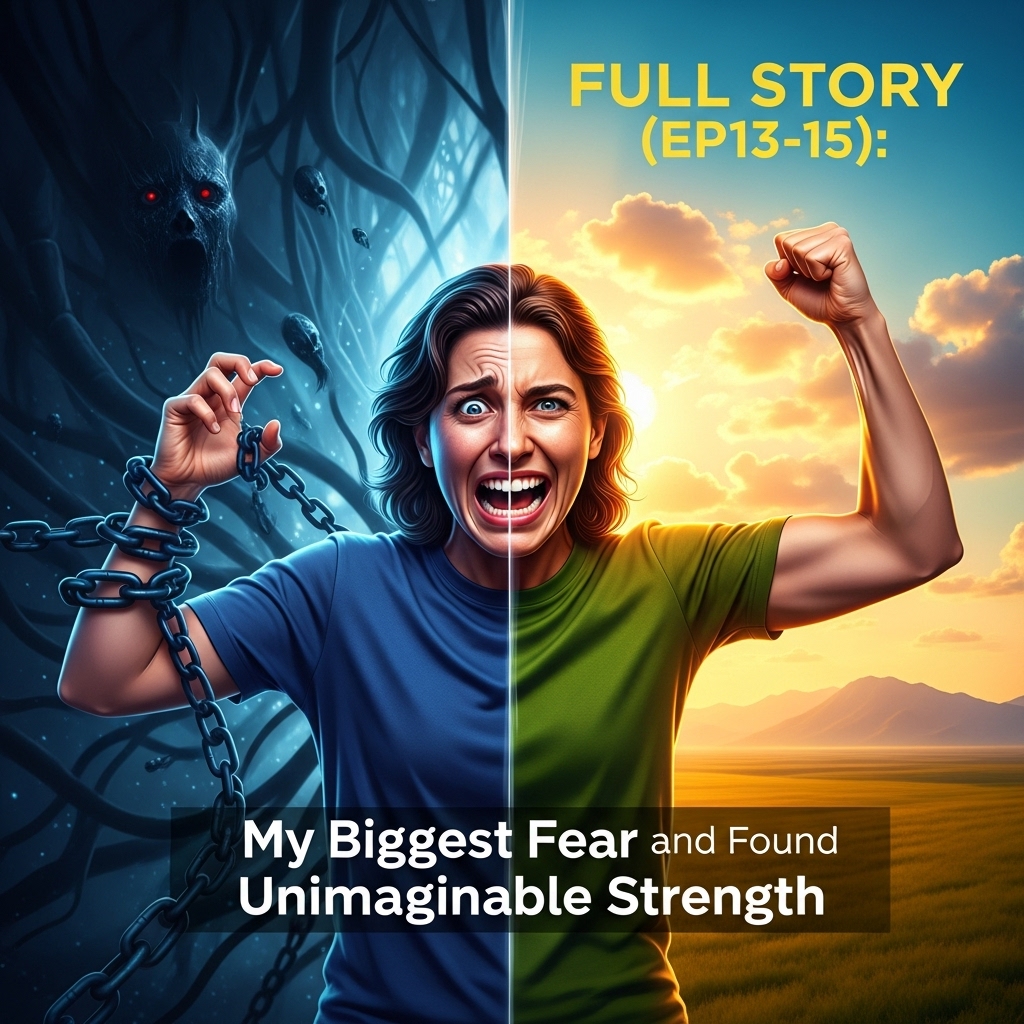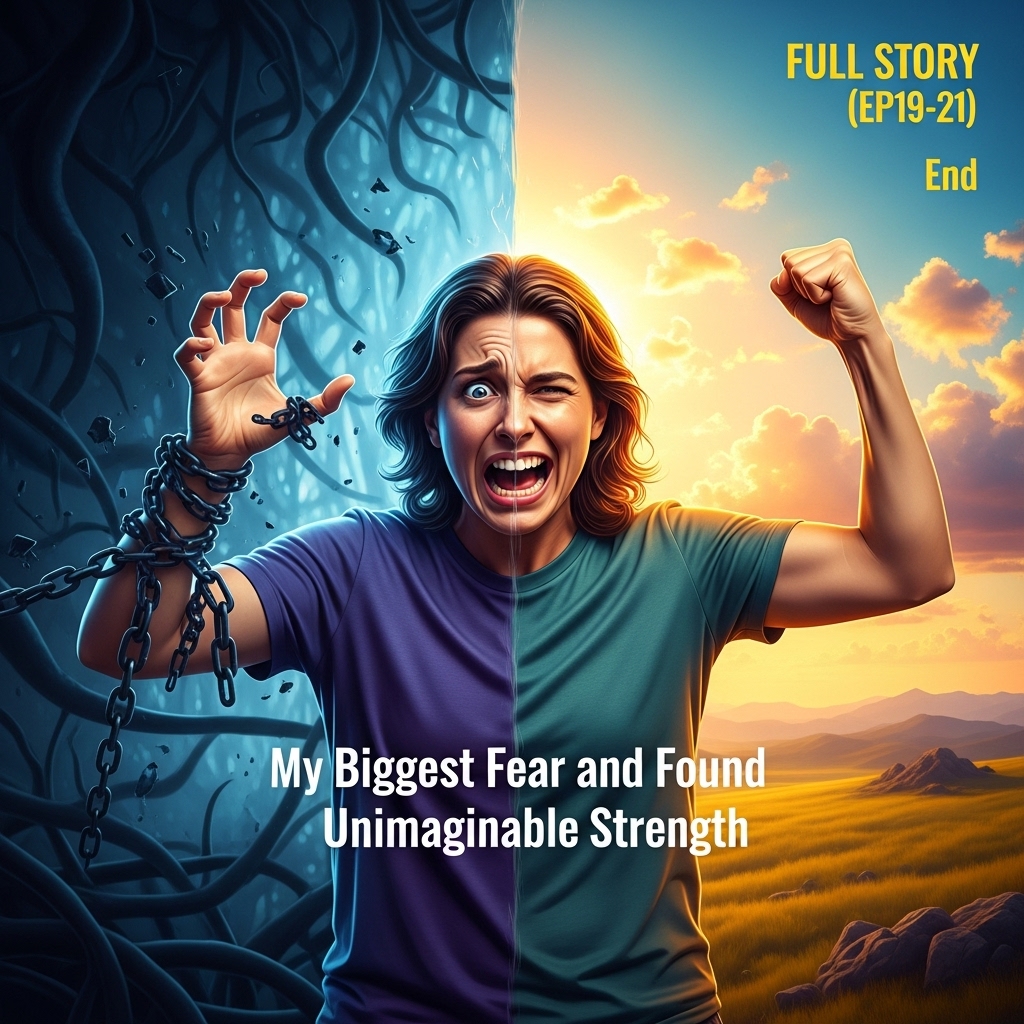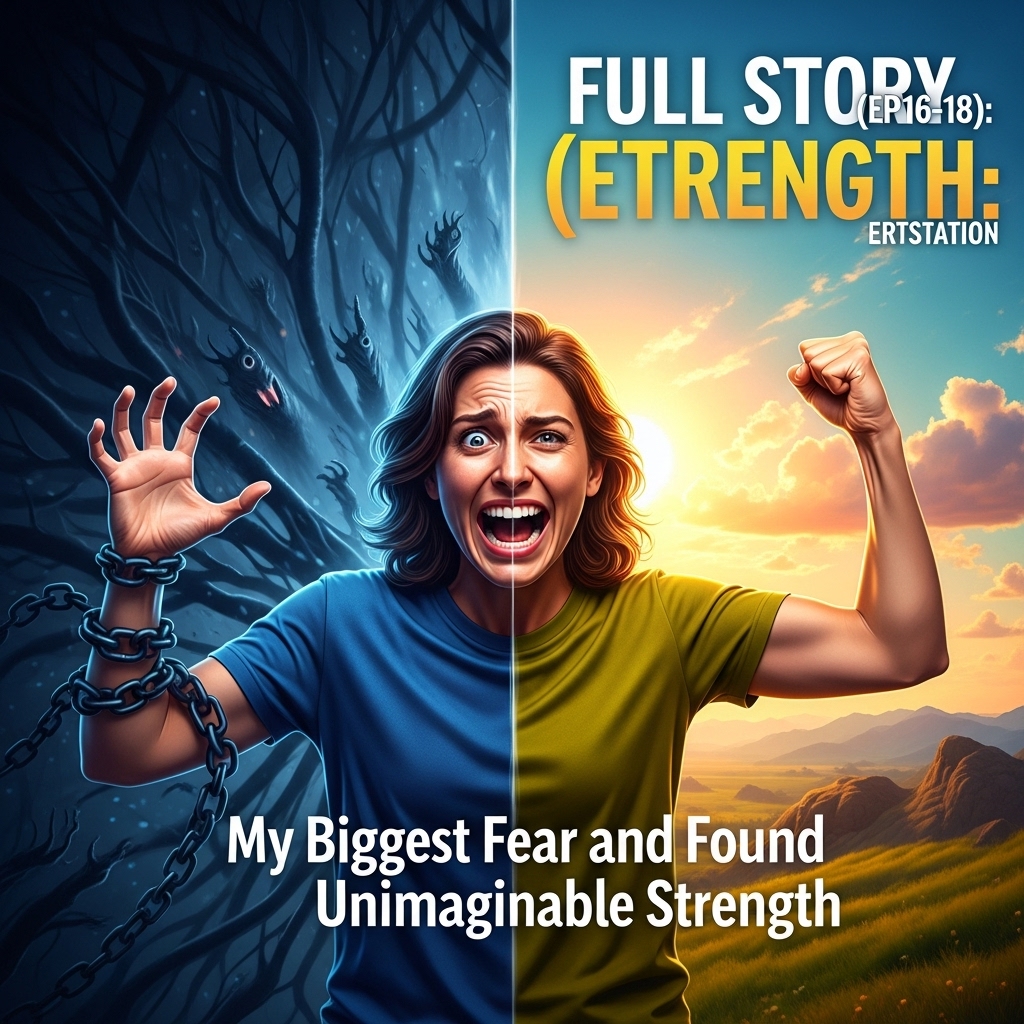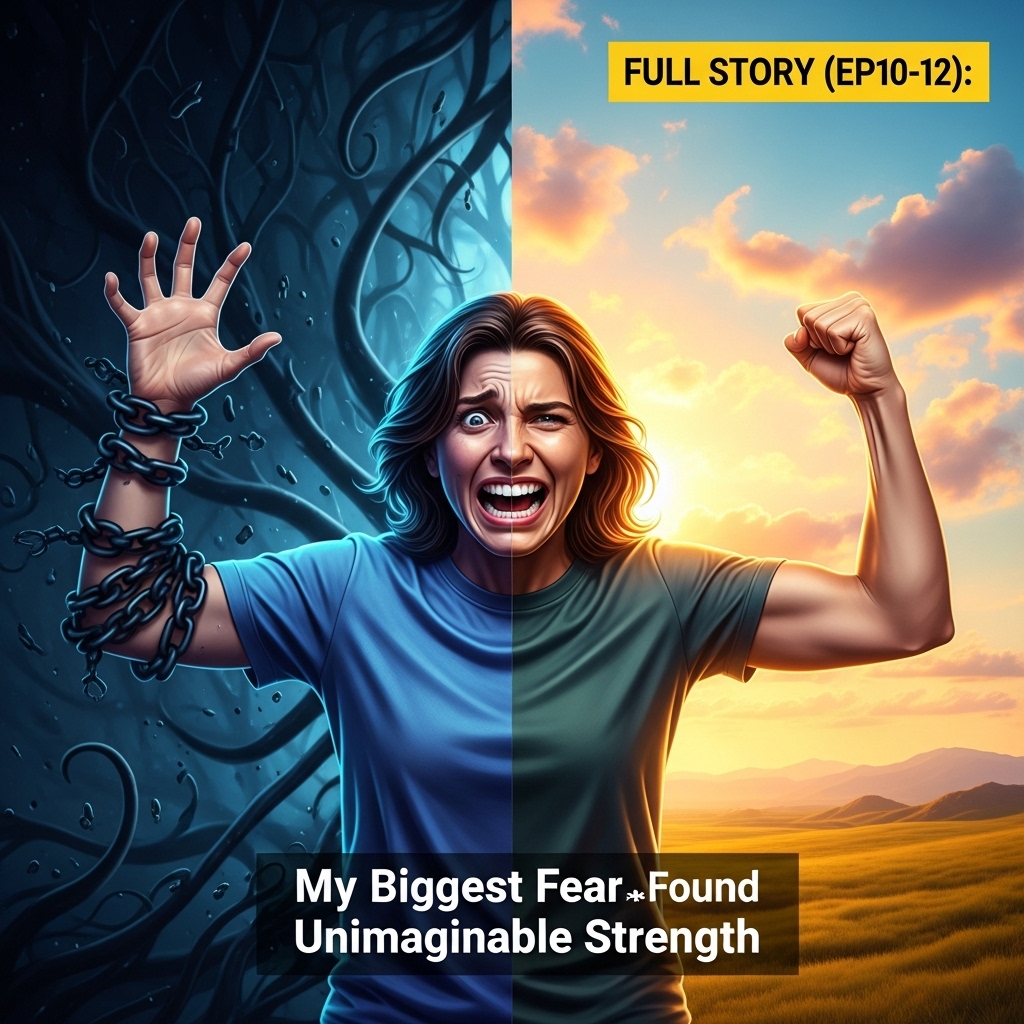Episode: 13
Over the next few weeks, these tiny leaps became my new routine. I would approach the supermarket, then walk to the entrance and stand by the automatic doors, just watching people go in and out. Then, I would step *just inside* the entrance, for a minute or two, allowing myself to be enveloped by the sounds and smells, the proximity of other people, before retreating. Each time, the anxiety was present, sometimes overwhelming, but each time, I stayed a little longer, allowed myself to feel it, and watched it dissipate. My breath became my most trustedcompanion, an internal anchor in the choppy waters of panic.
Then came the day for a more significant leap: entering the store and making a small purchase. This felt enormous. I chose a quiet time of day, armed with a list fora single, non-essential item. As I pushed the heavy cart through the automatic doors, the world seemed to sharpen into an overwhelming kaleidoscope of sound and light. The fluorescent hum, the murmur of voices, the squeak of cart wheels, the sheervolume of products on shelves – it all conspired to create a sensory assault. My internal alarm bells blared. My vision tunneled. I felt a desperate urge to bolt, to abandon the cart and flee back to the perceived safety of mycar.
But I had rehearsed this. I had imagined this moment countless times. I gripped the cart handle, focusing on the cold metal beneath my fingers. “One step at a time,” I whispered to myself. “Just tothe produce section. That’s all.” Every footfall felt heavy, deliberate. I could feel the eyes of other shoppers, even though I knew, rationally, they weren’t looking at me. They were just living their lives. Butmy fear projected onto them, making me feel exposed, vulnerable, as if my inner turmoil was radiating outwards for all to see.
I found the apples, picked one up, felt its smooth skin, its weight in my hand. Itwas a deliberate act of grounding, bringing me back to the present moment. The anxiety was a roaring beast in my chest, but I was still moving, still breathing. I then navigated to the checkout, the line seeming impossibly long,the waiting an exquisite form of torture. The social interaction with the cashier, however brief, felt like an Olympic event. Yet, I did it. I paid for my apple, took my bag, and walked out into the sunlight.As I walked away, the tension began to drain from my body, leaving me feeling like a deflated balloon. My legs were wobbly, my head light. I leaned against my car, clutching the single apple, and for a moment, tears welled up. Not tears of sadness, but of an overwhelming exhaustion mixed with a profound sense of accomplishment. I had done it. I had faced the beast in its lair, and I had emerged, not unscathed, but intact. This wasn’t about being comfortable; it was about demonstrating to myself, unequivocally, that I could *do* uncomfortable. That I could endure, and that the feared outcome, the catastrophic collapse, simply didn’t happen. The apple, thatperfectly ordinary apple, became a symbol of my quiet defiance, a trophy of my burgeoning courage.
These small, strategic victories built a new narrative within me. Each successful step chipped away at the old story of helplessness and avoidance. I beganto understand that the “strength” I was seeking wasn’t a sudden, magical transformation into someone immune to fear. Instead, it was the quiet, persistent act of showing up, of choosing to lean into discomfort rather than retreat, oftrusting in my own capacity to cope, even when every fiber of my being screamed otherwise.
The fear ladder continued. From the supermarket, we moved on to slightly more challenging environments: a small cafe during off-peak hours, a locallibrary, then eventually a public bus for a short ride. Each scenario brought its own unique flavor of anxiety, its own specific triggers. On the bus, it was the feeling of being trapped, the inability to control my exit. The rumbleof the engine, the jostling of bodies, the sense of confinement – it all coalesced into a potent cocktail of panic.
I remember my first bus ride particularly well. Dr. Vance suggested I pick a short route, just twostops, and ride it during a less busy time. Even knowing this, my heart was already pounding as I approached the bus stop. The waiting was almost worse than the ride itself. Every car that passed, every person who walked by, feltlike an interrogation. When the bus finally arrived, a hulking metal beast, I hesitated, my hand gripping the cold pole of the bus stop sign. “You can do this,” I told myself, channeling Dr. Vance’s calmvoice. “Just for two stops. You’re safe. You’re capable.”
Stepping onto the bus was like entering a different dimension. The air was thick, heavy with the scent of exhaust and unidentifiable stale odors. The seats were worn, some occupied by silent strangers, their faces obscured by books or headphones. I found a seat near the front, close to the door, a small concession to my need for an escape route. As the bus lurched forward, I could feel the tension coil in my stomach. My breath became shallow, my vision fixated on the window, trying to anchor myself to the outside world, to the familiar buildings and trees passing by.
The internal monologue was merciless: *What if it gets crowded? What if I can’t breathe? What if I have a full-blown panic attack right here, in front of everyone? They’ll stare. They’ll judge. I’ll makea fool of myself.* The physical sensations escalated: dizziness, tingling in my extremities, a terrifying detachment from reality. This was a full-blown internal crisis. My rational mind was screaming, *You know this is safe. You know thisfeeling will pass.* But my primal, fear-driven brain was convinced of imminent doom.
This was where the tools I had been practicing truly shone. I closed my eyes briefly, just for a second, and focused intently on the rhythm ofthe bus, the vibration through the seat. I took a deep, slow breath, feeling my belly expand, then slowly releasing it. I named the sensations: “My heart is racing. My hands are sweating. My mind is telling me I’min danger.” And then, the crucial part: “This is just anxiety. It’s uncomfortable, but it’s not dangerous. I can ride this wave.”
I repeated a silent mantra, a phrase Dr. Vance had given me:”I am safe. I am here. I am coping.” I opened my eyes and looked at a woman across the aisle, engrossed in her phone. She looked utterly serene, oblivious to my internal tempest. This tiny observation, thisglimpse into someone else’s normal, helped to puncture the intense self-focus of the panic. It reminded me that the world wasn’t ending, that others were simply living their lives, and that my internal experience, however dramatic, was largelyinvisible.
Episode: 14
When the bus approached my second stop, a wave of profound relief washed over me. I stood up, walked to the door, and stepped out onto the sidewalk, gulping in the fresh air. My legs were shaky, my headstill light, but I had done it. I had ridden the bus. It wasn’t enjoyable; it was a grueling test of endurance. But it was proof. Proof that I could navigate the terrifying landscape of my own anxiety, armedwith breath, self-compassion, and a fierce determination. Each of these direct confrontations, these “leaps,” reinforced the message: I was capable of facing what I feared most, and surviving. More than surviving, I was learningto *thrive* within the discomfort, knowing it was temporary.
One of the most profound lessons during these direct confrontations was the difference between *anticipatory anxiety* and the *actual experience* of the feared situation. The build-up to a feared event, the days and hours spent dreading it, imagining every catastrophic possibility, often felt far worse than the event itself. My mind, left unchecked, would create a monstrous, elaborate horror show that rarely, if ever, materializedin reality. When I was actually *in* the situation, while intensely uncomfortable, it was often less terrifying than the mental rehearsals. The concrete details of reality, the need to focus on navigating the environment, somehow grounded me more than the abstractterrors of my imagination.
This realization began to shift my relationship with anticipatory anxiety. Instead of letting it derail me, I started to view it as a signal, an old alarm system misfiring. “Oh, here’s that feeling again,” I would think. “It means I’m about to do something brave.” It wasn’t about erasing the anxiety, but reframing its meaning, giving it less power to dictate my actions.
The culmination of these gradualexposures led to what felt like the biggest, most terrifying leap of all. It was an event I had avoided for years, an experience that had become the ultimate symbol of my fear: attending a crowded, indoor concert. The idea alone sent shivers down my spine. The sheer volume of people, the confined space, the loud music, the feeling of being utterly engulfed and unable to escape. It was everything my phobia screamed at me to avoid.
But Dr. Vance andI had been working towards this. We planned meticulously. I wouldn’t go alone. A trusted friend, fully aware of my journey, would accompany me. We chose a venue with good ventilation and multiple exits, researching the layout beforehand. We agreedI would stay for a set amount of time, say, fifteen minutes, and if I felt I needed to leave, we would leave, no questions asked, no judgment. This built-in “escape clause” was psychologically crucial; it gaveme a sense of control, even if I hoped not to use it.
The day of the concert felt surreal. I was a bundle of nerves, my stomach in knots. Every minute leading up to it felt like an hour. Myfriend, bless her patience, was a steady, calming presence. As we approached the venue, the roar of the crowd, even from outside, was palpable. The energy, a mix of excitement and anticipation for others, was pure dread for me. Stepping inside was like walking into a wall of sound and bodies. The air was thick, warm, charged with electricity. Instantly, my system went into overdrive. My heart raced, my head swam, a wave of nausea rose in my throat. This was it. The moment I had feared for so long.
I clutched my friend’s arm, my knuckles white. “Okay,” I breathed, “I’m here.” My friend squeezed my hand, asilent affirmation. We found a spot near a wall, not too deep in the crowd, with a relatively clear path to an exit. I immediately felt the familiar pull to flee, the urgent, desperate desire to be anywhere but there. Thiswas intense, far more overwhelming than the supermarket or the bus. My entire being was screaming *DANGER! ESCAPE!*
But again, I leaned into my tools. I closed my eyes for a moment, taking a deep, shuddering breath, focusing on the coldness of the wall against my back. I named the sensations: “Heat, noise, crowded, panic.” And then, the vital reframe: “This is just a feeling. It will pass. I amsafe. My friend is here. I have an exit.” I opened my eyes, deliberately scanned the faces around me. People were laughing, singing along, lost in the music. Their joy was a stark contrast to my internal torment, andyet, it was also a reminder of reality: this was a place of enjoyment for many, not a place of imminent threat.
The first five minutes were excruciating. Every nerve ending felt raw, exposed. But then, as the bandlaunched into a particularly engaging song, something shifted. A small crack appeared in the wall of my panic. I started to focus on the music, on the rhythm, on the actual experience rather than just the terror of the environment. I stillfelt incredibly uncomfortable, but the edge of the panic began to dull, ever so slightly. It wasn’t gone, but it wasn’t the all-consuming monster it had been moments before.
I stayed for the fifteen minutes wehad agreed upon, then twenty, then thirty. Each minute felt like an achievement. There were moments when the anxiety surged again, when I felt the familiar wave of claustrophobia threaten to engulf me. But each time, I returned to my breath,to my grounding techniques, to the mantra: “I am safe. I am here. I am coping.” I didn’t engage in the revelry around me; I wasn’t singing or dancing. I was simply *being*there, present in the discomfort, observing it, allowing it to exist without letting it push me out.
After about forty-five minutes, I signaled to my friend that I was ready to leave. Walking out into the cool night air feltlike shedding a heavy cloak. My body was still trembling, my mind buzzing, but as I looked back at the brightly lit entrance of the venue, a profound sense of awe washed over me. I had done it. I had faced my ultimatefear, not perfectly, not without intense struggle, but I had faced it directly. I had stayed. And the world hadn’t ended. I hadn’t collapsed. I hadn’t made a fool of myself. I had simply*been* there, and endured.
Episode: 15
That night, as I replayed the experience in my head, I realized something truly transformative. The fear hadn’t vanished *during* the experience, but my *response* to it had changed. I had learned to coexist with the discomfort, to ride the waves of panic without being capsized. The “leap of faith” wasn’t about jumping into a void and suddenly finding courage. It was about taking deliberate, informed steps, each onebuilding on the last, each one a testament to my growing resilience. It was about consistently choosing courage over comfort, even when comfort was screaming its seductive promises. It was about accepting that the journey wouldn’t be painless, but trusting that I had thetools and the inner fortitude to navigate the pain, and emerge stronger on the other side. This critical action, facing the concert head-on, was the most powerful validation yet that the strength I sought was not outside me, but had been growing withinme all along.The cool night air that enveloped me as I stepped out of the concert venue felt different. It wasn’t just a physical sensation; it was as if the very molecules of the air carried a newfound clarity, a quiet hum of revelation. Mybody, though still quivering with the aftershocks of intense adrenaline, also held a strange, undeniable lightness. It wasn’t the giddy rush of triumph, but a deeper, more profound sense of peace. The world hadn’t ended.I hadn’t crumbled. I had simply *been* there, present in the crucible of my deepest fear, and I had endured.
This wasn’t a moment of fireworks and trumpets, but rather the quiet unfolding of along-held secret. The strength I had been searching for, the resilience I had yearned to possess, hadn’t arrived like a bolt of lightning. Instead, it was unpeeling itself, layer by gentle layer, from thevery core of my being. This chapter, “Unveiling Strength: The Surprising Discoveries of Resilience and Inner Power,” is where the true transformation began to reveal itself, not as an outcome, but as an ongoing process of discovery.
The morning after the concert, I awoke to a stillness I hadn’t felt in years. It wasn’t merely the absence of external noise; it was an internal quietude. The usual morning chorus of anxious thoughts, the subtleclenching in my stomach, the insistent buzz of apprehension—all were muted, almost absent. I lay there for a long time, simply breathing, noticing the sunlight filtering through the curtains, the gentle weight of the blanket. It was asif a lifelong tension had finally begun to loosen its grip. This wasn’t to say that all fear had vanished, far from it. The memory of the surging anxiety inside the venue was still fresh, but it was now a memory, nota present threat. It was like looking at a distant storm through a window; you knew it had raged, but you were safe within.
This initial calm was perhaps the first surprising discovery: that relief wasn’t necessarily an explosive joy, but often a deep, quiet sense of internal peace. It taught me that strength wasn’t about the absence of struggle, but the capacity for stillness amidst its echoes. My mind, usually a battlefield of “what if” scenarios, wasnow curiously reflective. I began to re-evaluate what had actually happened. My initial goal, in some unspoken corner of my mind, had perhaps been for the fear to simply disappear, for me to magically transform into someone who felt no anxiety in large crowds. But that hadn’t happened. I had felt the fear, intensely. Yet, I had stayed.
This was the critical distinction, the first major unveiling of true strength: it wasn’t about eradicating the fear, but aboutchanging my *relationship* with it. For so long, fear had been the unquestioned tyrant, dictating my movements, my choices, my very sense of self. It was a thick, impenetrable wall. But in that concert hall, somethingshifted. I had looked at the wall, acknowledged its existence, felt its immense presence, and then, surprisingly, I had found a way to simply *be* in its proximity without letting it define me. I had seen its power,yes, but I had also witnessed my own, quiet power to observe it, to breathe through it, to simply endure its presence.
This realization began to reshape my understanding of resilience. Before, I might have imagined resilience as an unyielding shield, deflecting all harm. Now, I saw it as something far more nuanced and profound. It was the capacity to feel the impact, to bend without breaking, to flow around obstacles rather than constantly fighting against them. It was less about brute force andmore about adaptable strength, like a reed in the wind. Each time I had felt the panic rising inside the venue, and each time I had returned to my breath, to my grounding, to my mantra, I wasn’t fighting the fear head-on in a battle of wills. I was simply *practicing* coexistence. I was demonstrating to myself, in the most visceral way possible, that I could feel immense discomfort and still be okay. This wasn’t a grand, heroicgesture; it was a series of small, persistent acts of self-regulation and self-trust.
I started to view my body differently, too. For years, it had felt like a betrayer, a vessel of anxiety that wouldseize up, sweat, and tremble at the slightest provocation. Now, I began to see it as an incredibly sensitive instrument, yes, but also one with immense capacity for self-correction and healing. The physical sensations of anxiety, which oncefelt like a precursor to disaster, now began to feel more like intense feedback. My heart racing wasn’t a sign of impending doom; it was a natural physiological response to perceived threat, one that my body was capable of managing. My tremblinghands weren’t a mark of weakness; they were simply a sign that my nervous system was working overtime, and that I was still standing, still choosing to face the moment.
This shift in perception wasn’t intellectual; it was deeplyembodied. I started to pay more attention to the subtle cues my body gave me. When I felt a flicker of anxiety in other situations—a busy grocery store, a crowded elevator—instead of immediately recoiling or trying to suppress it,I would pause. I would observe the sensation, acknowledge it, and then deliberately soften my jaw, relax my shoulders, take a deeper breath. It was as if I was sending a gentle, reassuring message to my nervous system: “Isee you. I hear you. We are safe.” This practice, born from the intense experience of the concert, became a daily ritual of self-attunement.
Another profound discovery was the transformation of my inner dialogue. For solong, my internal voice had been dominated by a harsh critic, a fearmonger whispering dire predictions. “You can’t do this.” “You’ll look foolish.” “It’s too much.” After the concert, thisvoice didn’t vanish entirely, but its volume decreased significantly. More importantly, another voice began to emerge, one that was quieter, steadier, and infinitely more compassionate. It was the voice that had guided me through the concert: “I amsafe. I am here. I am coping.” This new voice wasn’t about denial or forced positivity; it was about gentle reassurance, realistic assessment, and unwavering support.



